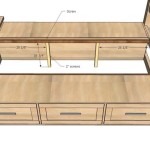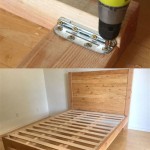How to Make a Raised Bed on a Slope
Cultivating a garden on a sloped terrain presents unique challenges. Soil erosion and water runoff can become significant issues, making it difficult to create a thriving environment for plants. However, with the use of raised beds, these difficulties can be overcome. Raised beds provide a stable platform for planting, allowing for better soil management and control over drainage. This article will guide you through the process of constructing a raised bed on a slope, addressing considerations for design, materials, and installation.
Choosing the Right Location and Design
The first step in building a raised bed on a slope is selecting the optimal location and determining the most suitable design.
- Sun Exposure: Consider the amount of sunlight your plants require. Choose a location that receives adequate sun throughout the day.
- Slope Angle: The angle of the slope will influence the design and construction of the raised bed. A gentle slope may allow for a more traditional rectangular design, while a steep slope will require a more complex structure.
- Drainage: Ensure that the location has adequate drainage to prevent waterlogging. If the area tends to accumulate water, consider incorporating drainage features into the design.
- Access: Choose a location that is easily accessible for planting, weeding, and harvesting.
Once you have chosen a location, you can begin to consider the design. There are several options for raised bed designs on slopes, including:
- Stacked Beds: Stacked beds are constructed by building layers of retaining walls, creating a series of stepped terraces. This design is particularly well-suited for steep slopes.
- Contour Beds: Contour beds follow the contours of the slope, creating a series of level planting areas. This design helps to conserve water and reduce erosion.
- Combination Designs: You can also combine different designs to create a unique and effective raised bed system.
Selecting and Preparing Materials
The next step is to choose the materials for construction. Consider the following factors when making your decision:
- Durability: The materials should be durable enough to withstand the elements and the weight of the soil.
- Aesthetics: Choose materials that complement the style of your garden.
- Cost: Set a budget for the materials and choose options that fit within your financial constraints.
Common materials for raised beds include:
- Timber: Pressure-treated lumber is a durable and readily available option.
- Stone: Natural stone offers a rustic aesthetic and can be long-lasting.
- Concrete Blocks: Concrete blocks provide a sturdy and affordable option.
- Recycled Materials: Consider utilizing recycled materials such as pallets, bricks, or old tires to create a unique and eco-friendly raised bed.
Once you have chosen your materials, you will need to prepare them for construction. This may involve cutting, shaping, and securing the materials.
Constructing the Raised Bed
The process of constructing a raised bed on a slope will vary depending on the chosen design and materials. However, there are some general steps that apply to most projects.
- Excavation: If your design requires it, excavate the ground to create a level base for the raised bed.
- Foundation: Build a solid foundation to support the weight of the raised bed. This may involve laying a layer of gravel or concrete.
- Framing: Construct the frame of the raised bed using your chosen materials. Anchor the frame securely to the foundation.
- Finishing Touches: Add any finishing touches, such as edging or decorative elements.
When constructing a raised bed on a slope, it is crucial to consider the angle of the slope and ensure that the bed is properly supported. You may need to use support beams or additional bracing to prevent the bed from sliding or shifting.
Filling the Raised Bed
After the raised bed is constructed, it's time to fill it with appropriate soil. Select a high-quality potting mix or garden soil that is well-drained and provides adequate nutrients for your plants.
- Drainage: Add a layer of gravel or drainage material at the base of the raised bed to improve drainage.
- Soil Blend: Mix the soil with compost, manure, or other amendments to enrich the soil and provide essential nutrients.
- Depth: Fill the raised bed with enough soil to accommodate the root system of the desired plants.
It is important to consider the specific needs of the plants you intend to grow when choosing the soil and filling the raised bed. Some plants may prefer a lighter, more aerated soil, while others may benefit from a heavier, clay-based mix.
Building a raised bed on a slope requires careful planning and construction techniques. By following these guidelines, you can create a beautiful and functional raised bed that will enhance your garden and provide a thriving growing environment for your plants.

How To Build An Organic Raised Bed On A Sloped Yard Deeply Southern Home

How To Build Raised Garden Beds On A Slope

These Bricks Make Building Raised Garden Beds Simple Wirecutter

How To Build Raised Garden Beds On A Slope

How To Build An Organic Raised Bed On A Sloped Yard Deeply Southern Home

How To Build A Terraced Garden Bed On Slope

Raised Bed Primer Guest Post From Jenny Peterson The Garden Buzz

Diy Terrace Garden Bed Flaming Petal Blog

How To Build Raised Garden Beds On A Slope Or Hillside

How To Build Raised Garden Beds On A Slope
Related Posts







